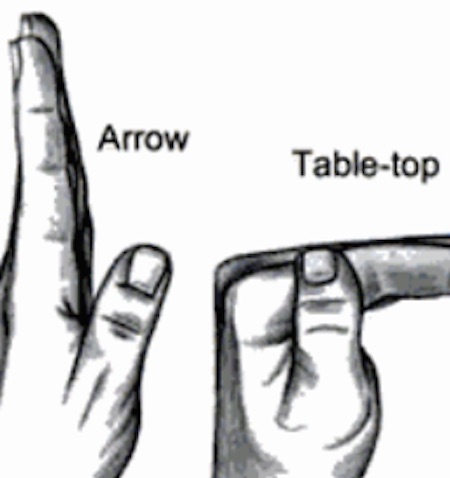Arthritis: Base of the Thumb at the Wrist
What Is It?
In a normal joint, cartilage covers the end of the bones and serves as a shock absorber to allow smooth, pain-free movement. In osteoarthritis (OA, also called degenerative arthritis) the cartilage layer wears out, resulting in direct contact between the bones and producing pain and deformity. In the hand, one of the most common joints to develop OA is the base of the thumb. The thumb basal joint, also called the carpometacarpal (CMC) joint, is a specialized saddle-shaped joint that is formed by a small bone of the wrist (trapezium) and the first bone of the thumb (metacarpal).The saddle shaped joint allows the thumb its wide range of motions, including up, down, across the palm, and the ability to pinch (see Figure 1).

Figure 1: Thumb Basal Joint
Who Gets It?
OA at the base of the thumb at the level of the wrist is more commonly seen in women over the age of 40.The exact cause is unknown, but genetics, previous injuries such as fractures or dislocations, and generalized joint laxity may predispose towards development of this type of arthritis.
What Are the Symptoms and Signs?
The most common symptom is pain at the base of the thumb at the level of the wrist. The pain can be aggravated by activities that require pinch, such as opening jars, turning door knobs or keys, and writing. Also pain can progress to at rest and at night. In more severe cases, progressive destruction and mal-alignment of the joint occurs, and a bump develops at the base of the thumb, which occurs as the metacarpal moves out of the saddle joint. This shift in the joint can cause limited motion and weakness, making pinch difficult (see Figure 2). The next joint above the CMC may compensate by loosening, causing it to bend further back (hyperextend).

Figure 2: In severe cases, the thumb collapses into the palm and wrist, causing a zig-zag deformit
How is the Diagnosis Made?
The diagnosis is made by history and physical evaluation. Pressure and movement such as twisting will produce pain at the joint. A grinding sensation may also be present at the joint . X-rays are used to confirm the diagnosis, although symptom severity often does not correlate with the x-ray findings. Often special X-ray views of the thumb and the wrist: including good images of the thumb and trapezial views of the wrist are needed to fully delineate the arthritis.

BASE OF THE THUMB METACARPAL AND CORRESPONDING STAGE.
The X-ray stage of the arthritis at the base of the thumb metacarpal has been shown to correlate with cartilage thickness and smoothness. Often in stage one it is very difficulkt to detect any xray changes despite changes to the articular cartilage. In stage II early joint spurs form at the edges of the joint. These are typically less than 2mm in size. In stage III there is joint space narrowing as well as small joint spurs ans fragments. Finally in stage IV arthritis there is a narrow to often obliterated joint space and large bone spurs know as osteophytes and changes to the subchondral bone ( bone just below the cartilage) often referred to as subchondral cysts and sclerosis or "whitening" of the bone on a standard xray image.
What are the Treatment Options?
Less severe thumb arthritis will usually respond to non-surgical care. Arthritis medication, splinting and cortisone injections may help alleviate pain. A hand therapist might provide a variety of rigid and non-rigid splints which can be used while sleeping or during activities. However a rigid splint may irritate the skin if there are prominent bone spurs and can cause increase pain if too much immobilization occurs.
Recently topical medications such as a prescription anti-inflammatory gel have had some success.
Patients with advanced disease or who fail non-surgical treatment may be candidates for surgical reconstruction. A variety of surgical techniques are available that can successfully reduce or eliminate pain. Surgical procedures vary and may include a combination of removal of arthritic bone and joint reconstruction , joint fusion, bone realignment, capsulodesis, tendon transfers, ligament reconstruction, release of contractures and even arthroscopy in very rare select cases. A consultation with your hand surgeon can help decide the best option for you.
Additional references
Diagnostic Value of Clinical Grind Test for Carpometacarpal Osteoarthritis of the Thumb
parts adapted/taken/modified from material on ASSH website by www.handctr.com
portions: © 2006 American Society for Surgery of the Hand
Developed by the ASSH Public Education Committee


 copy.jpg)
